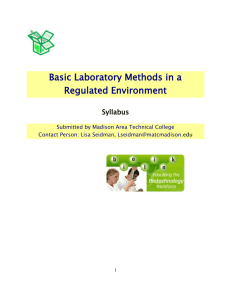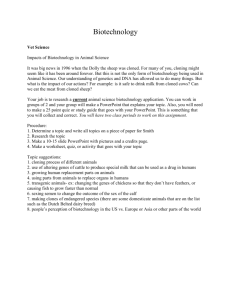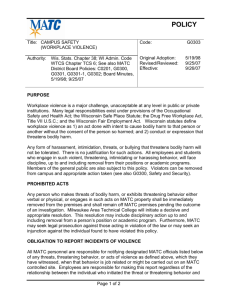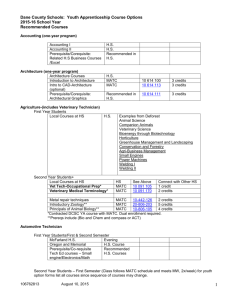History and timetable of program development
advertisement
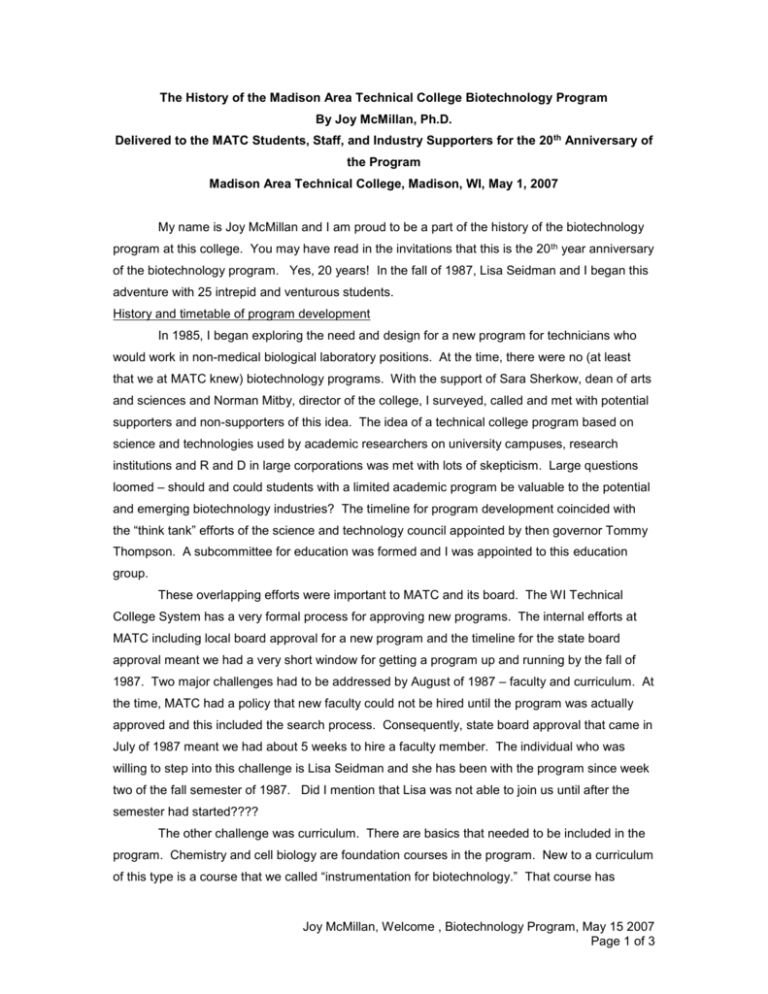
The History of the Madison Area Technical College Biotechnology Program By Joy McMillan, Ph.D. Delivered to the MATC Students, Staff, and Industry Supporters for the 20 th Anniversary of the Program Madison Area Technical College, Madison, WI, May 1, 2007 My name is Joy McMillan and I am proud to be a part of the history of the biotechnology program at this college. You may have read in the invitations that this is the 20 th year anniversary of the biotechnology program. Yes, 20 years! In the fall of 1987, Lisa Seidman and I began this adventure with 25 intrepid and venturous students. History and timetable of program development In 1985, I began exploring the need and design for a new program for technicians who would work in non-medical biological laboratory positions. At the time, there were no (at least that we at MATC knew) biotechnology programs. With the support of Sara Sherkow, dean of arts and sciences and Norman Mitby, director of the college, I surveyed, called and met with potential supporters and non-supporters of this idea. The idea of a technical college program based on science and technologies used by academic researchers on university campuses, research institutions and R and D in large corporations was met with lots of skepticism. Large questions loomed – should and could students with a limited academic program be valuable to the potential and emerging biotechnology industries? The timeline for program development coincided with the “think tank” efforts of the science and technology council appointed by then governor Tommy Thompson. A subcommittee for education was formed and I was appointed to this education group. These overlapping efforts were important to MATC and its board. The WI Technical College System has a very formal process for approving new programs. The internal efforts at MATC including local board approval for a new program and the timeline for the state board approval meant we had a very short window for getting a program up and running by the fall of 1987. Two major challenges had to be addressed by August of 1987 – faculty and curriculum. At the time, MATC had a policy that new faculty could not be hired until the program was actually approved and this included the search process. Consequently, state board approval that came in July of 1987 meant we had about 5 weeks to hire a faculty member. The individual who was willing to step into this challenge is Lisa Seidman and she has been with the program since week two of the fall semester of 1987. Did I mention that Lisa was not able to join us until after the semester had started???? The other challenge was curriculum. There are basics that needed to be included in the program. Chemistry and cell biology are foundation courses in the program. New to a curriculum of this type is a course that we called “instrumentation for biotechnology.” That course has Joy McMillan, Welcome , Biotechnology Program, May 15 2007 Page 1 of 3 evolved since that first semester but it remains a cornerstone of the program. The curriculum has evolved since that first year, but the focus has remained. Are the students learning what they need to be effective technicians in an ever-changing industry? Also, the program had to offer courses in recombinant DNA technologies and genetic engineering, topics found in many academic references and research articles, but not in instructional resources. Factors enabling the exploration and development of a new program I want to emphasize why this program was possible. Some of it was simply being naïve yet confident enough to believe that the emerging biotechnology industry would benefit by such a program. Internal college support for the program was also critical to making the program happen. Unlike many programs where models existed in other states, the biotechnology program at MATC had no forerunners and became the model for many two year college biotechnology programs. While those of us who worked at the program level were taking professional risks with our careers, the college was also taking a risk supporting a program that was academically challenging and had no known employer base. The college was staking its reputation in supporting emerging technologies and the workforce needed to sustain the companies arising from the R and D world. It was clear that employment in most R and D operations at this time (whether within an academic laboratory or research institute) was based on hiring persons who had a bachelor’s degrees. However, we believed that this was where the technical college could be of value – develop programs and courses to hone technical skills that complement the academic skills of students whether they are recent high school graduates, persons with bachelor’s degrees or returning adults. In 1994, we were awarded our first National Science Foundation grant in the Advanced Technological Education program. This enabled us to refine curriculum, build external partnerships locally and around the country, and hire additional faculty and staff. Since that first award, we have had four additional awards in biotechnology, the most recent being the award for the Post-Baccalaureate Intensive Program. In addition, MATC is a partner with other two year colleges across the country in Bio-Link, the National Center of Excellence in Biotechnology Education. Since 1998, MATC has been the North Central Regional Center for this national center. Today’s challenges are still revolve around internal as well as external barriers. The extensive laboratory experience for students is expensive and the costs continue to climb. When we lacked certain pieces of equipment, Lisa and I jokingly drew the instrumentation on a box to simulate certain aspects for students. Now the program staff must consider how to replace and upgrade the aging equipment. The courses have evolved, but the need for each student to experience each aspect of a protocol or to complete the documentation and calculations remains. This is still a challenge for the faculty and staff. Limited equipment means students must stagger their work and this in turn means long hours for faculty and staff. However, it is also critical for Joy McMillan, Welcome , Biotechnology Program, May 15 2007 Page 2 of 3 students to understand the relationship of this experience to the real world. Science doesn’t happen in a strictly 9 to 5 world. Why do this…. Locally, Madison Area Technical College has a unique role and opportunity. The links between MATC and University of Wisconsin- Madison are strengthened at all levels as faculty, administrators and students move between the two institutions. MATC is responsible for workforce and economic development – that’s part of its mission. Consequently, MATC must be flexible enough to react to potential industry development as a consequence of the tech transfer from the university. This is very important if MATC is to remain true to its charge and provide the area citizens with opportunities to be prepared for new kinds of work. Today’s WI State Journal had a small blurb about money available from the state for additional training in emerging industries. The goal is make more training available for fields like biotechnology, stem-cell research, renewable energy and advanced manufacturing. This is like an echo of the efforts from the mid-80’s. Some of the emerging technologies of today are variations of the emerging technologies of 20 years ago. How has the colleges met the challenges. In 2002, I was funded by NSF for curriculum in renewable energy technologies. That project resulted in a broader effort to provide faculty development and curriculum for renewable energy in many of the existing technical program areas. Since my retirement from MATC, the renewable energy project has moved to other faculty and staff. The passing of the baton to others is critical if the college is to respond to the needs of its constituents – students and employers. The challenge to be aware of the changing landscape relies on faculty and staff with external contacts and links. It is then incumbent upon the administration of the college to support these efforts with resources. Congratulations to students and faculty … it has been a journey that is worth reflecting upon! Joy McMillan, Welcome , Biotechnology Program, May 15 2007 Page 3 of 3


